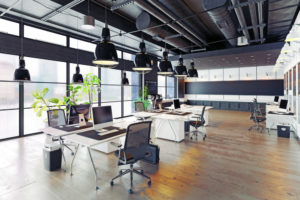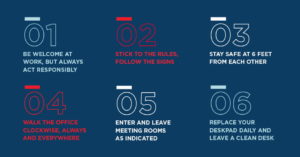It’s hard to believe that in March, millions of office workers crammed onto busy highways, entered busy offices and shook dozens of hands. By April, many were questioning if anyone would ever safely go back to an office.
As offices cautiously reopen, what changes are in store?
Spaces will evolve for the new normal, creating new opportunities for office assets. Check out these three trends that will impact the office market.
Demands for Safer Office Space

– Creating new patterns of office circulation
– Signage directing safe walking areas
– Providing workers with disposable paper mats for desk tops
– Placing furniture with a 6′ radius around each employee.
(More information on the 6′ office available at Cushman & Wakefield.
Technology improvements will help limit exposure to high touch surfaces like door handles. For example, elevator systems that use key car access create a touchless experience. Offices with motion sensing light switches as green upgrades will also be ahead of the curve.
In the short term, expect hand sanitizer stations to become a part of every lobby and entrance. Property management companies are providing extra cleaning and sanitizing services.
For better or worse, the era of sealing the deal with a handshake is probably over.
More Telecommuting
Based on census data from FlexJobs.com, remote work grew 159% between 2005 and 2017. Montana hosts the 4th highest percent of telecommuters in the US.
Employers have mixed views on telecommuting, both before and after the pandemic forced workers into home offices.
Some employers report increased productivity from the home based work force during COVID-19. But for every employee excited to ditch the commute, there is another who can’t take another Zoom meeting at the kitchen table.
As offices reopen, more employees may be able to work from home, only visiting the office on occasion.
For Montana, this could lead to a growth in new residents. A recent study of knowledge workers showed that 70% would like to be able to live outside of major metros. Pre-pandemic, secondary markets like Missoula and Bozeman were growing. Major metros were losing population due to high cost of living and traffic.
Post-pandemic, expect top talent looking for a change in scenery to continue migrating into the Last Best Place.
Coworking Will Survive
Sometimes misunderstood in the office market, coworking space will survive- and maybe even thrive. The old perception of coworking as a giant open space with hotdesking and a ping pong table in the corner is changing. Before the pandemic moved the office from social to socially distant, coworking spaces were already evolving.
Coworking products offer diverse spaces and appeal to a variety of tenants. Flexible lease terms and spaces offer private offices, conference rooms, and other amenities for small companies. These amenities used to be limited to larger, more expensive spaces with long term leases.
For corporations, coworking relieves the need for overflow space in the short term. In new markets, these products are a stop-gap while procuring more permanent space. Coworking space remains viable in the long term as demand for flexible leases, remote work space and access to amenities grows.
In Montana, small office space is in high demand. Office products in this category will be an excellent fit for entrepreneurs and remote workers looking to get out of home offices. Adapting these spaces for medical services (like massage therapists and chiropractors) increases appeal.
So what do all these changes mean for you?
The traditional office space likely won’t go the way of the dinosaur, but proactive measures are crucial. Successful employers must proactively seek safe spaces for workers.
Flexibility will be expected from building owners in the coming years. Tenants will likely be working to “right size” into spaces that accommodate social distancing and teleworking.
Looking for more information on these office space trends and what it means for your assets or workforce? Contact Nick Chaussee.




